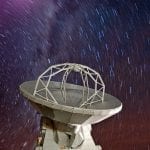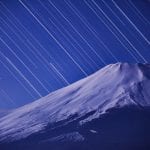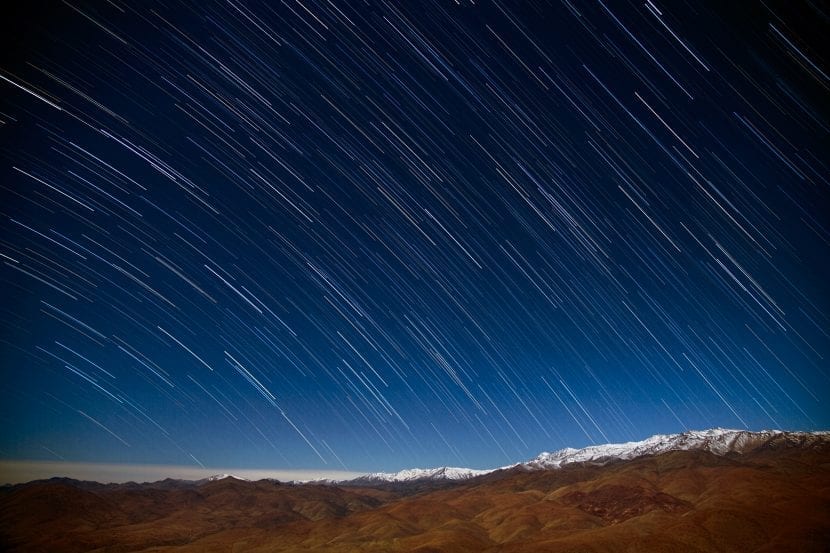
La rain of stars, or meteor shower, is an astronomical phenomenon of singular beauty that, fortunately, we can enjoy a lot simply by observing the sky. But how is it formed? And, most importantly, if possible, What days can you see?
If you are interested in knowing everything about the meteor shower, do not stop reading.
What is the Meteor Shower?
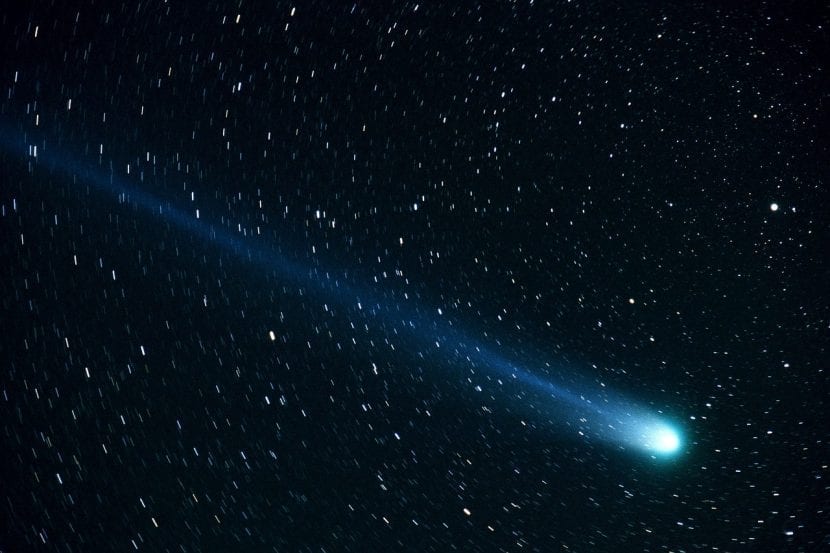
In outer space there are comets, meteorites, asteroids, and various astronomical objects which, when approaching the interior of the Solar System, the wind from the king star causes the surface to activate; So, the gases and materials that compose them go out into space so that a stream or ring of particles is formed which is known as a meteor swarm. If it is a meteor, this swarm is often called a shooting star.
The light effect is produced by the ionization of the atmosphere generated by the particle. Most of the meteors that come into contact with the Earth's atmosphere are very small, like grains of sand, so when they disintegrate at about 80-100km high the effect is not very impressive; However, there are others, the fireballs, which disintegrate at a height of 13-50km, leaving an amazing flash of light.
How to identify shooting stars?
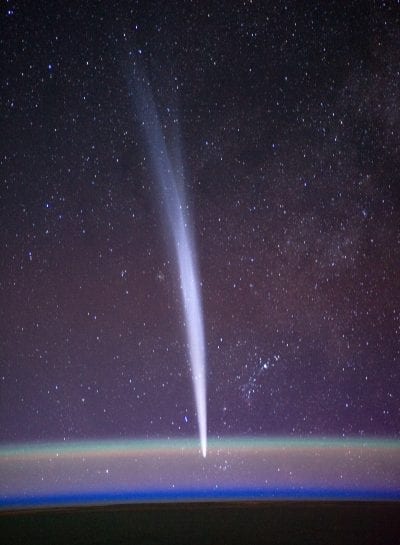
This phenomenon has three characteristics that make it unique: the radiant, the population index and the Zenital Hourly Rate or THZ.
- Radiant: it is the point from which the meteors stop coming out of a shower. It is measured by the coordinates Alpha, which is the right ascension or AR, and Delta, which is the declination or Ddec.
- Population index: is the brightness ratio between the members of the same meteor swarm.
- Zenital Hourly Rate: is the calculated maximum number of meteors that an observer could see in case the sky was clear, the Moon was not full, and there was no light pollution.
List of meteor showers
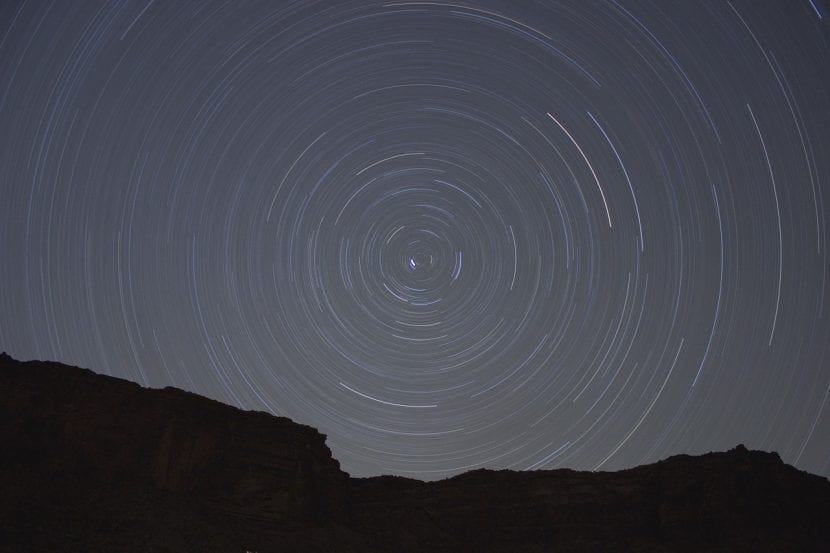
Here is a list of all the meteor showers of the International Meteor Organization (IMO):
| Rain | Period of activity | Maximum | Radiant | V_infinite | r | thz | ||
|---|---|---|---|---|---|---|---|---|
| Date | Salt | α | δ | km / s | ||||
| Quadrantids (QUA) | Jan 01-Jan 05 | Jan 03 | 283 ° 16 | 230° | + 49 ° | 41 | 2.1 | 120 |
| δ-Cancridas (DCA) | Jan 01-Jan 24 | Jan 17 | 297° | 130° | + 20 ° | 28 | 3.0 | 4 |
| α-Centaurides (ACE) | Jan 28-Feb 21 | February 07 | 319 ° 2 | 210° | -59 ° | 56 | 2.0 | 6 |
| δ-Leonids (DLE) | Feb 15-Mar 10 | February 24 | 336° | 168° | + 16 ° | 23 | 3.0 | 2 |
| γ-Normids (GNO) | Feb 25-Mar 22 | Márta 13 | 353° | 249° | -51 ° | 56 | 2.4 | 8 |
| Virginids (VIR) | Jan 25-Apr 15 | (Mar 24) | (4 °) | 195° | -04 ° | 30 | 3.0 | 5 |
| Lyrid (LYR) | Apr 16-Apr 25 | Apr 22 | 032 ° 32 | 271° | + 34 ° | 49 | 2.1 | 18 |
| π-Puppid (PPU) | Apr 15-Apr 28 | Apr 24 | 033 ° 5 | 110° | -45 ° | 18 | 2.0 | var |
| η-Aquarids (ETA) | Apr 19-May 28 | May 05 | 045 ° 5 | 338° | -01 ° | 66 | 2.4 | 60 |
| Sagittarids (SAG) | Apr 15-Jul 15 | (May 19) | (59 °) | 247° | -22 ° | 30 | 2.5 | 5 |
| June Bootidas (JBO) | Jun 26-Jul 02 | Meitheamh 27 | 095 ° 7 | 224° | + 48 ° | 18 | 2.2 | var |
| Pegasids (JPE) | Jul 07-Jul 13 | July 09 | 107 ° 5 | 340° | + 15 ° | 70 | 3.0 | 3 |
| Julio Phoenícidos (PHE) | Jul 10-Jul 16 | July 13 | 111° | 032° | -48 ° | 47 | 3.0 | var |
| Pisces Austrinids (PAU) | Jul 15-Aug 10 | July 28 | 125° | 341° | -30 ° | 35 | 3.2 | 5 |
| δ-South Aquarids (SDA) | Jul 12-Aug 19 | July 28 | 125° | 339° | -16 ° | 41 | 3.2 | 20 |
| α-Capricornids (CAP) | Jul 03-Aug 15 | July 30 | 127° | 307° | -10 ° | 23 | 2.5 | 4 |
| ι-South Aquarids (SIA) | Jul 25-Aug 15 | Aug 04 | 132° | 334° | -15 ° | 34 | 2.9 | 2 |
| δ-North Aquarids (NDA) | Jul 15-Aug 25 | Aug 08 | 136° | 335° | -05 ° | 42 | 3.4 | 4 |
| Perseids (PER) | Jul 17-Aug 24 | Aug 12 | 140° | 046° | + 58 ° | 59 | 2.6 | 100 |
| κ-Cygnides (KCG) | Aug 03-Aug 25 | Aug 17 | 145° | 286° | + 59 ° | 25 | 3.0 | 3 |
| ι-North Aquarids (NIA) | Aug 11-Aug 31 | Aug 19 | 147° | 327° | -06 ° | 31 | 3.2 | 3 |
| α-Aurigid (AUR) | Aug 25-Sep 08 | Sep 01 | 158 ° 6 | 084° | + 42 ° | 66 | 2.6 | 10 |
| δ-Aurigid (DAU) | Sep 05-Oct 10 | Sep 09 | 166 ° 7 | 060° | + 47 ° | 64 | 2.9 | 5 |
| Piscides (SPI) | Sep 01-Sep 30 | Sep 19 | 177° | 005° | -01 ° | 26 | 3.0 | 3 |
| Draconids (GIA) | Oct 06-Oct 10 | Deireadh Fómhair 08 | 195 ° 4 | 262° | + 54 ° | 20 | 2.6 | var |
| ε-Geminids (EGE) | Oct 14-Oct 27 | Deireadh Fómhair 18 | 205° | 102° | + 27 ° | 70 | 3.0 | 2 |
| Orionids (ORI) | Oct 02-Nov 07 | Deireadh Fómhair 21 | 208° | 095° | + 16 ° | 66 | 2.5 | 23 |
| South Taurids (STA) | Oct 01-Nov 25 | November 05 | 223° | 052° | + 13 ° | 27 | 2.3 | 5 |
| North Tauridas (NTA) | Oct 01-Nov 25 | November 12 | 230° | 058° | + 22 ° | 29 | 2.3 | 5 |
| Leonidas (LEO) | Nov 14-Nov 21 | November 17 | 235 ° 27 | 153° | + 22 ° | 71 | 2.5 | 20+ |
| α-Monocerotides (AMO) | Nov 15-Nov 25 | November 21 | 239 ° 32 | 117° | + 01 ° | 65 | 2.4 | var |
| χ-Orionids (XOR) | Nov 26-Dec 15 | December 02 | 250° | 082° | + 23 ° | 28 | 3.0 | 3 |
| Phoenicides Dec (PHO) | Nov 28-Dec 09 | December 06 | 254 ° 25 | 018° | -53 ° | 18 | 2.8 | var |
| Puppid / Fluffy (PUP) | Dec 01-Dec 15 | (Dec 07) | (255 °) | 123° | -45 ° | 40 | 2.9 | 10 |
| Monocerotids (MON) | Nov 27-Dec 17 | December 09 | 257° | 100° | + 08 ° | 42 | 3.0 | 3 |
| σ-Hydrides (HYD) | Dec 03-Dec 15 | December 12 | 260° | 127° | + 02 ° | 58 | 3.0 | 2 |
| Geminids (GEM) | Dec 07-Dec 17 | December 14 | 262 ° 2 | 112° | + 33 ° | 35 | 2.6 | 120 |
| Eat Berenicides (COM) | Dec 12-Jan 23 | December 19 | 268° | 175° | + 25 ° | 65 | 3.0 | 5 |
| Ursids (URS) | Dec 17-Dec 26 | December 22 | 270 ° 7 | 217° | + 76 ° | 33 | 3.0 | 10 |
Important:
- Rain: indicates the name and abbreviation of the rain.
- Period of activity: are the days during which it is active.
- Maximum:
- Date: is the date on which a greater number of meteors can be seen.
- Sun: Solar Longitude. It is the measure of the position of the Earth on its orbit.
- Radiant: are the coordinates of the position of the radiant of the rain. α is Right Ascension, δ is Declination.
- v infinite: speed reached by meteors when entering the atmosphere. It is given in km / s.
- r: is the population index. If r is above 3.0, it means that it is weaker than average; instead if it is 2.0 to 2.5 then it will be brighter.
- thz: is the Zenital Hourly Rate. If it is high, THZE is used. If it is variable, it indicates »var».
How to see meteor showers?
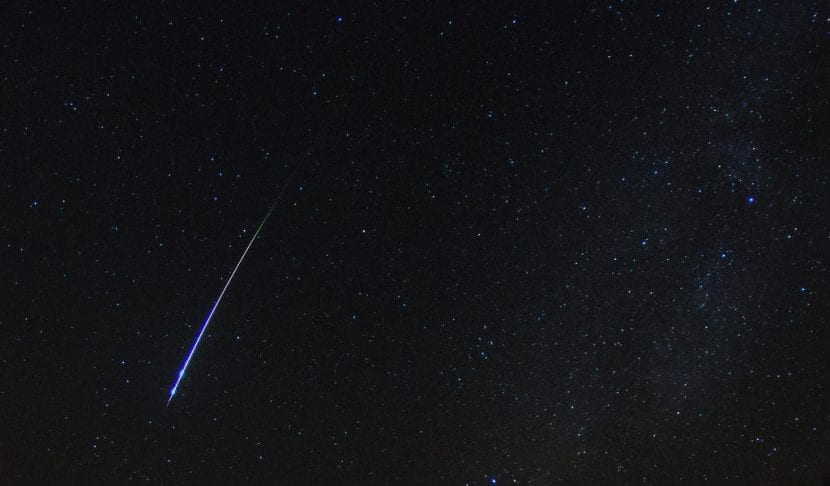
Shooting stars can be seen with the naked eye, as long as the sky is clear and the Moon is not full, but unfortunately with the advancement of cities it is increasingly difficult to enjoy them to the fullest. Therefore, If you want to contemplate its beauty, you have to get away as much as possible from the urban centers.
Take the opportunity to go with your loved ones to the countryside or mountains to observe them. Surely you will have a great time 🙂.
Main meteor showers and dates they are seen
As we have seen, there are many swarms of shooting stars that can be seen throughout the year, but the best known are the following:
- Quadrantids: its activity period runs from January 1 to 5, with its maximum being January 3. It is one of the most active rains of the year, with a Zenith Hourly Rate of 120 meteors / h.
- Lyrid: its period of activity extends between April 16 and 25, with its maximum being 22. Its THZ is 18 meteors per hour.
- Perseids: also called the Tears of San Lorenzo. Its period of activity extends from July 17 to August 24, with its maximum between 11 and 13. The Zenith Hourly Rate is 100 meteors / h.
- Draconids: sometimes called Giacobinids. They are a rain whose period of activity is understood from October 6 to 10, reaching its maximum on 8. It has a variable Zenith Hourly Rate.
- Orionids: they are a rain of moderate activity whose period of activity extends from October 2 to November 7, reaching a maximum on October 21. Its Zenith Hourly Rate is 23 meteors per hour.
- Leonidas: they are a rain that whose period of activity extends from November 15 to 21, and reaches a maximum of activity every 33 years. Its Zenith Hourly Rate is 20 meteors / h.
- Geminids: it is one of the rains with the highest activity. They have a period of activity that extends from December 7 to 17, and the day that reaches its maximum is the 13. The Zenith Hourly Rate is 120 meteors per hour.
Shooting star images and video
Images
To finish, we leave you with these magnificent images of rains seen from different parts of the world.
